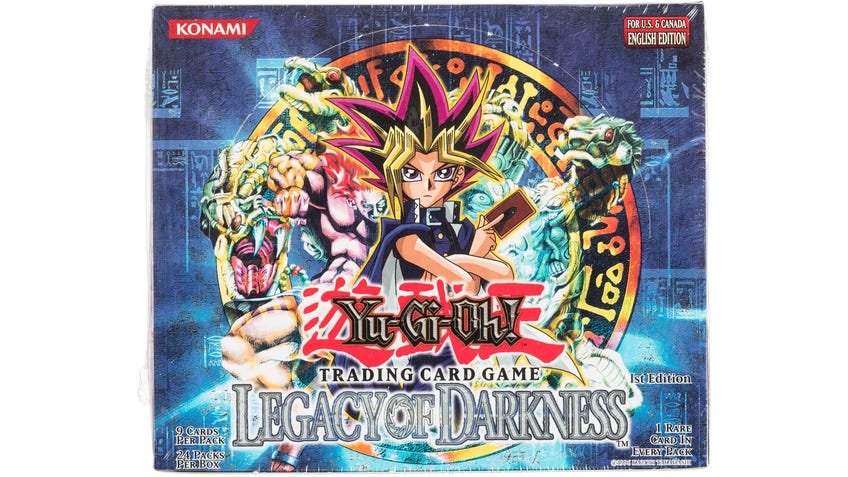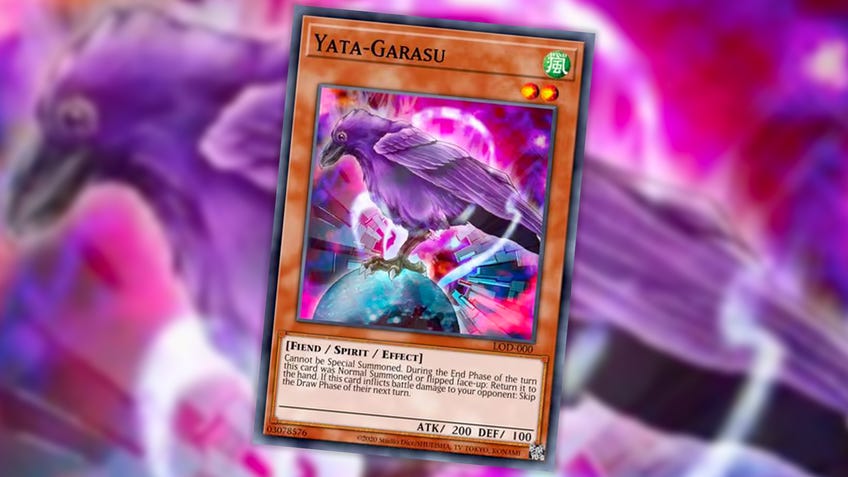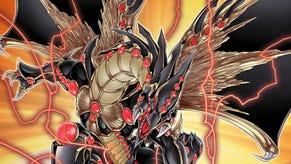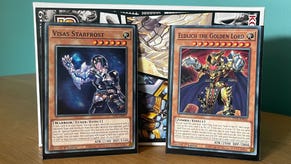The story of Yata-Lock, the deck that broke Yu-Gi-Oh! and birthed the TCG's first competitive banlist
Bird of prey.
The idea of a banlist in Yu-Gi-Oh! feels standard by now, a necessary tool used to balance the card game and prevent a shift from variety and enjoyment for all players to single-deck dominance or the game-ruining destruction possible with overpowered cards. After all, players want to have fun - and the same cards for all eternity because they overpower or obstruct what comes before is no fun for anyone.
Yet in the earliest days of this game, the idea of a regularly-updated centralised banlist which all official tournaments followed was simply not a thing. Even if some stores stepped in to decree their own rules if players objected, it was far from a standardised affair like we see today. Even as new sets released and an initial limited list released in May 2002 prevented some of the most overpowered cards being run at numbers of three per deck, the idea of completely excluding a card from competitive play was unheard of. Until one deck - or more precisely, one bird - changed all of that.
This is the Yata-Lock: the deck that broke Yu-Gi-Oh! and ushered in the very first banlist in Yu-Gi-Oh!’s history.
To first consider what the competitive scene looked like at the time that the Yata-Lock strategy first burst onto the scene, Yu-Gi-Oh! was a far simpler game to play and win than it is today. With far fewer effect monsters and even fewer options to bring out additional monsters via special summons, beyond revival cards like Monster Reborn and the occasional exception, duels often revolved around preventing your opponent from overcoming your own field so you could eventually tribute-summon boss monsters like Summoned Skull or Blue-Eyes White Dragon that would most likely win you the game. There were other counters like equip cards and other paths to victory beyond this, but this was the general strategy.
2002 and 2003 were the edge of a precipice for the Yu-Gi-Oh! TCG.
While the game had steadily evolved beyond these simplistic origins as monsters like Mystic Tomato reshaped the game as we knew it, many of these effects were still slow-acting and retrospectively appear weak in the context of modern Yu-Gi-Oh! Yet 2002 and 2003 were the edge of a precipice for the TCG; cards like Sangan and the aforementioned creatures were just the start of a transformation of the game into the fast-paced spectacle we’re familiar with today. While Yu-Gi-Oh! had some limitations on the card pool in place at the time, to put the brakes on some of the most powerful cards like Raigeki, Dark Hole and Fiber Jar, no card was banned from competitive play.
The release of Legacy of Darkness in June 2003 was a tentpole set that transformed the direction of Yu-Gi-Oh! forever, with its introduction of powerful effect monsters like Injection Fairy Lily starting a shift that would eventually usurp the power and relevance of Normal monsters from all but a few decks. Of all cards released in that set, however, a certain small bird would infuriate and frustrate opponents to such an extent that publisher Konami and at-the-time distributor Upper Deck had no choice but to intervene.

On the surface, Yata-Garasu has just 200 ATK and looks almost tame, especially in today's landscape. Two conditions factored into its rise to the top of Yu-Gi-Oh! First was its effect: should Yata-Garasu successfully inflict damage to an opponent’s life points, it could force your opponent to skip their next draw phase. Such an effect is so powerful that even today few cards will directly interfere with a player’s draw phase. To not draw prevents new cards entering the game; if the opponent has no counter the first time, they certainly won’t the next turn, or the turn after that.
The second issue was that, even if you happened to possess a monster in your hand that could overpower Yata-Garasu, it wouldn’t stay on the field long enough to make a difference. This is a Spirit monster, a mostly-forgotten mechanic in Yu-Gi-Oh! that returns these monsters automatically to the hand at the end of the turn. Even if you technically had the cards to overcome the bird, it could fly away before you had a chance to swipe it aside.

No wonder, following the card’s release, it would soon come to dominate the competitive scene. Once the World Championships were held in Madison Square Garden in 2003, the deck was dominant, and the final was a mirror match which hinged almost entirely on whoever was lucky enough to pull the purple pest first. In the end, the championships were won by Ng Yu Leung:
Monsters:
- 2 Don Zaloog
- 1 Fiber Jar
- 3 Gemini Elf
- 1 Jinzo
- 1 Kycoo the Ghost Destroyer
- 1 Magician of Faith
- 3 Mystic Tomato
- 1 Sangan
- 1 Sinister Serpent
- 1 Witch of the Black Forest
- 1 Yata-Garasu
Spells:
- 1 Change of Heart
- 1 Confiscation
- 1 Dark Hole
- 1 Delinquent Duo
- 1 Graceful Charity
- 1 Harpie’s Feather Duster
- 1 Heavy Storm
- 1 Mirage of Nightmare
- 1 Monster Reborn
- 3 Mystical Space Typhoon
- 1 Nobleman of Crossout
- 1 Pot of Greed
- 1 Premature Burial
- 1 Raigeki
- 1 Snatch Steal
- 1 The Forceful Sentry
Traps:
- 1 Call of the Haunted
- 3 Drop Off
- 1 Imperial Order
- 1 Mirror Force
- 1 Ring of Destruction
Side Deck:
- 1 Airknight Parshath
- 3 Book of Moon
- 3 Electric Snake
- 1 Exiled Force
- 1 Kycoo the Ghost Destroyer
- 1 Painful Choice
- 1 Scapegoat
- 3 Torrential Tribute
- 1 White Magical Hat
The strategy of a Yata-Lock deck was simple, to the point that the sheer power and ease-of-use of the technique was a major contributor as to how this deck so easily rose to its dominant status within competitive Yu-Gi-Oh! A lock could be achieved by getting Yata-Garasu onto the field as quickly as possible to inflict direct damage on your opponent, preventing them from drawing additional cards and essentially stunning the opponent in place. If you didn’t already have a card to counter it in your very next turn, it was over.
Yata-Garasu's sheer power and ease-of-use was a major contributor as to how the deck so easily rose to its dominant status in competitive Yu-Gi-Oh!
In turn, the aim of the deck was to bring the bird out and protect it while wiping any potential counter from your opponent’s disposal. With Dark Hole, Raigeki and Harpie’s Feather Duster, removing counter spells, traps and monsters was trivial - had you not already blocked them from being activated with control monsters like Jinzo or Imperial Order. It was easily searched thanks to its weak stats by searchers like Sangan and Witch of the Black Forest. And if your opponent had any counter monsters strong enough to block Yata-Garasu from inflicting direct damage, Change of Heart and Snatch Steal could quite literally swipe them away before they caused any harm.
In the end, though Yata-Garasu didn’t have too much of an influence over the final match of the event (it was only summoned in a single duel and swiftly countered), its presence was known. As the match report from the time notes, just the presence of the card being summoned left many to assume the game was over, the fear this card instilling in all who played through this influential period of the game became apparent. Only by using Torrential Tribute to wipe the card from the field could they have the hope of prolonging a match that many assumed was over as soon as the card was summoned.

The domination of Yata-Garasu didn’t end with this tournament, either. With Spirit Reaper and other cards came even more ways to control your opponent’s hand and field, only making the bird’s power all that much harder to match. And even if the deck wasn’t built around Yata-Garasu, the ability to almost seal any match when it made its way onto the field meant it was sprayed into just about every deck in the game. With the release of Chaos Emperor Dragon - Envoy of the End and its ability to send all cards on field and in hand to the graveyard, you now had a two-card combo with searchers like Witch of the Black Forest to immediately search for Yata-Garasu and win the game.
When Yata-Garasu was released it was the first time the young TCG had confronted a card with an effect so powerful it was almost impossible for many decks to overcome.
It was unavoidable, and there was resentment for the bird across the competitive scene of the era. Something had to be done. While far from the only problem card, the 2004 World Championships the following year banned the card, and the first banlist was implemented across the TCG in October. A similar list was already in place in Japan as of March of that year, banning many of the cards we’ve mentioned in this piece for their sheer overwhelming strength and ability to restrict and control your opponent, and the ban was implemented early for this event to ensure parity between the regions. Fiber Jar, Injection Fairy Lily, Change of Heart, Delinquent Duo and Imperial Order were just a few cards now banned from competition, alongside, of course, the bird.
To this day, many of the cards banned at this time continue to feature on the list today. While no longer banned, Change of Heart was only removed from the banlist in May last year, and remains limited to a single card per deck. Cards like Delinquent Duo, Imperial Order and Fiber Jar remain banned. Yata-Garasu, meanwhile, having been unbanned for the first time since this fateful day at the same time as Change of Heart, returned to an Unlimited state in February of this year. Even in 2003 at the World Championships, the card was limited to one copy per deck.
So what’s changed?
Although the card remains a threat, the Spirit monster’s inherent inability to be special summoned requires the use of your only Normal summon and reduces its viability in a game so reliant on special summons from all areas of the field. More crucial to the card’s weakness today is the growth of cards whose effects activate in the Graveyard. Even without a single card on the field or in hand that would once seal the lock, decks that revolve around effects activated in the Graveyard can still turn things around. While no longer a dominant force in today's meta, the Tenyi archetype continues to see competitive play and has effects revolving around their activation in the Graveyard.
Simply put, there are stronger cards today than what existed in 2003. When Yata-Garasu was released it was the first time this young card game had confronted a card with an effect so powerful it prevented your opponent from playing that it was almost impossible for many decks to overcome. Now, even when decks do rise to the surface and become the ones to beat in any format, few feel quite as unassailable or unfair as the Yata-Lock once did in 2003.
While it’s likely that with or without Yata-Garasu we would have eventually seen a banlist in the game (every game faces this issue eventually as it’s near-impossible to balance a game with that many cards for so many years, and other cards were a threat), it’s no surprise that this bird was the card turning this eventuality into a necessity, and that even today the 2003 Yata-Lock era is looked back upon with trepidation.









